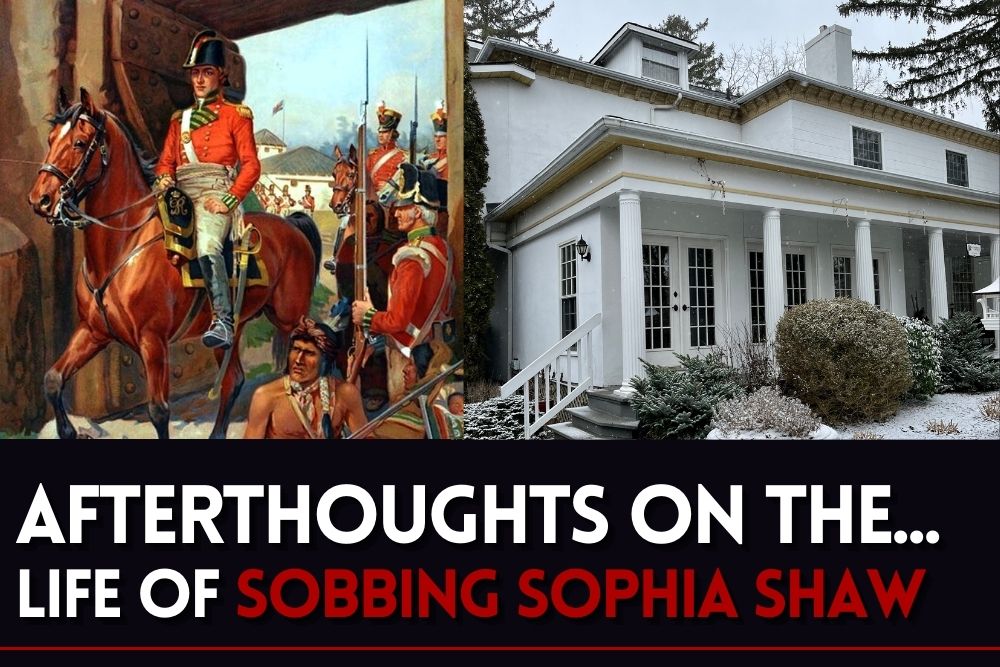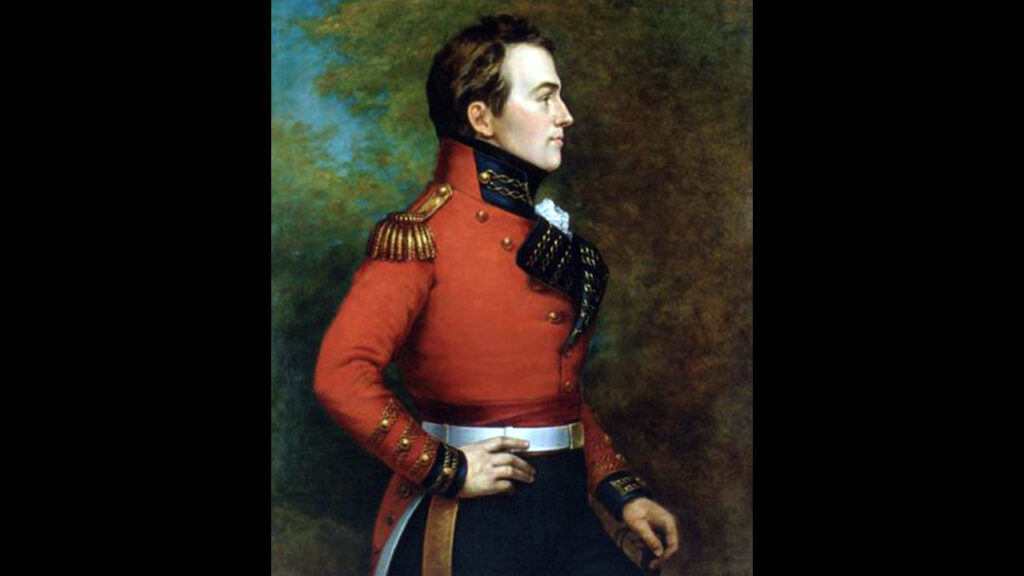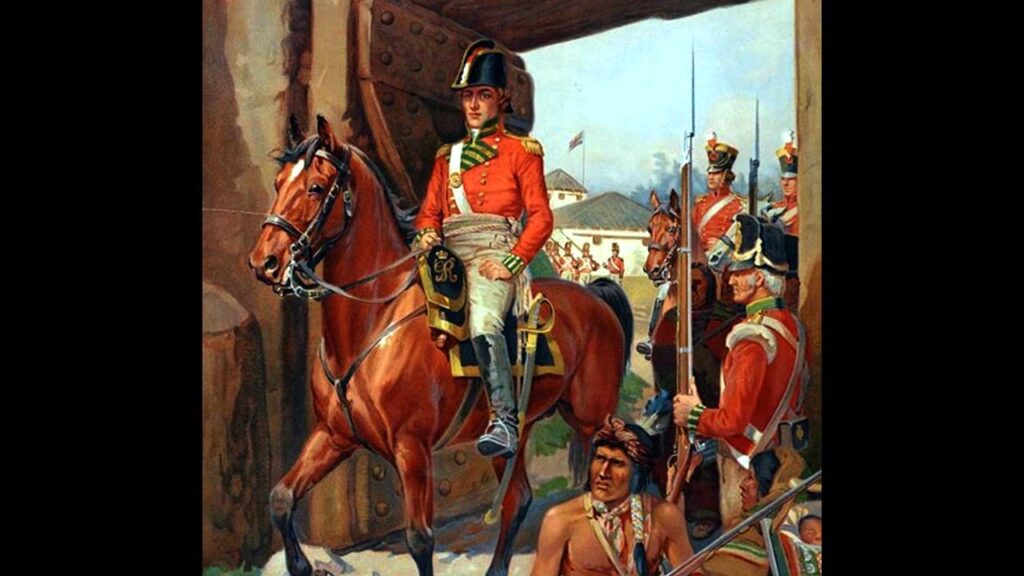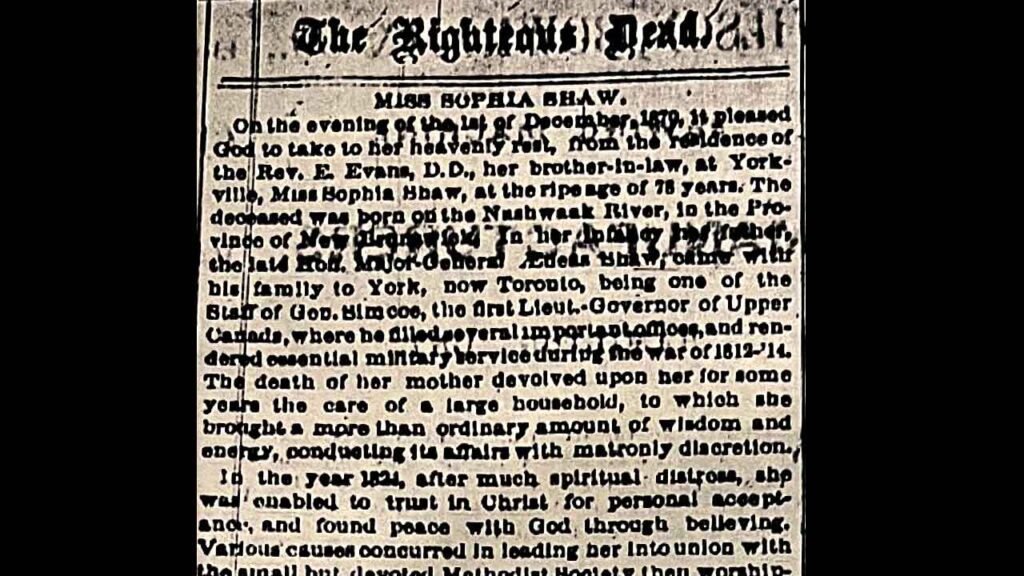Finding the Connection between General Isaac Brock & “Sobbing Sophia” Shaw in Niagara-on-the-Lake.
It has been said that a life that’s well lived defines a person in remembrance. But one brief, precious episode in a person’s lifetime could change the course of the river of fate.
This is how legends begin. And one such story started with the final meeting between Sophia Shaw and Major-General Sir Isaac Brock. As he rode his horse hard towards the direction of Queenston Heights. Many books and blogs had been written about their enduring romance.
At least one play was composed based on their love affair and the war that ended their relationship in tragedy.
..: Quick Links :..
Connection | Macdonell | Death | Legend of Sobbing Sophia
Ghost Guide Daniel Reads the Article

Article by Richard Ong
Much has been written about Sir Isaac Brock and his military exploits as a war hero of what would later become the country of Canada. But what do we really know about Miss Shaw beyond the stories of her association to Brock?
During my research, I learned a little bit more about her as a person, through the narrative of one who knew her well.

Family Connection
Her life as we know it did not begin with her birth near the Nashwaak River in the Province of New Brunswick in 1792. It started in the early morning of October 13, 1812, at the Battle of Queenston Heights, when Major-General Sir Isaac Brock mounted his horse in Fort George and galloped south towards the sound of battle. On his heels were his two trusted aides-de-camp, Lieutenant-Colonel John Macdonell and his close friend, Captain John Baskerville Glegg.
According to Walter R. Nursey, who first published a book in 1908 that briefly mentioned the attachment between Brock and Sophia (the source of the legend)…
“Our hero made a brief stop, without dismounting his horse, at the residence of Captain John Powell, home of Sophia Shaw. He accepted a cup of coffee from her, both fearing that this could be the last time they would be together.“
His two aides-de-camp surely would have been witness to such a tender moment.

John Macdonell
One could certainly hope that some correspondences would have survived the ravages of time as evidence of such an important and sad event. Unfortunately, Lieutenant-Colonel John Macdonell followed Isaac Brock to his grave the day after. He was only twenty-six years old.
While digging through Brock University’s digital archive, I came upon a letter written by Captain John Powell. Of the 1st Lincoln Militia addressed to his sister Mary Boyles Powell (dated around October, 1812).
Captain Powell owned the residence on King Street where Sophia lived at the time. The letter included an account of the death of Lieutenant-Colonel John Macdonell, the younger aide-de-camp of Sir Isaac Brock.
In Love with Mary Powell
John Macdonell was in love with Mary. Her brother “included a lock of the lieutenant-colonel’s hair with an inscription. ‘Killed at Queenston Heights by the Americans, October 13, 1812, Lieut. Col. John Macdonnell’.” (7).

Just the year before, Macdonnell wrote a love poem to Mary Powell that began with: “Adieu. Adieu and it is so | And must I from sweet Mary, go” (7). A copy of this poem also can also be found in Brock University’s digital archive. So now, we have learned that on that fateful day, two related women lost their love in defense of this future nation.
With the death of Lieutenant-Colonel John Macdonell. The one surviving aide-the-camp that could’ve witnessed Brock and Sophia’s final farewell at the Powell residence was Captain John Baskerville Glegg.
Just like Macdonnell, he too accompanied Major-General Sir Isaac Brock on his way from Fort George to Queenston Heights. As Brock’s close friend, Glegg “had the principal role in arranging Brock’s funeral on October 16, 1812.” (8) One could not help but wonder if John Glegg possessed any memoirs that mentioned of his friend’s attachment to Sophia Shaw.
Sophia Shaw’s Life After Brock
But the saga of Sophia Shaw was far from over. Sir Isaac Brock’s death was only the beginning of her trials in life. She was destined never to marry. Whether it was due to her devotion to Brock as legend would have it, or a sense of higher purpose.
Much of what I have learned about her life came from a lengthy obituary. Titled, “The Righteous Dead”. Written by her brother-in-law, the Reverend Ephraim Evans, D.D., sometime after her death on December 1, 1870 in Yorkville (Toronto).

Reverend Evans was a Methodist missionary and minister who was married to Sophia’s sister, Charlotte. This valuable piece of information was included in a scrapbook handed over from one owner to the next. Owners of the bed-and-breakfast inn where I stayed at Niagara-on-the-Lake.
Unfortunately, we do not know the name of its original publication. However, with the help of the Toronto Reference Library staff. I was able to locate a shorter obituary of Sophia Shaw. From their digital archives, dated December 3, 1870 as published from The Daily Globe (now called, The Globe and Mail). Which validates the contents of “The Righteous Dead.”
Sophia Shaw’s mother died years before the war, leaving the young teen-aged daughter the “care of a large (family) household.” (2) Her father, Æneas Shaw, passed away in 1814, leaving her an orphan. With all of these tragedies in her life, she began to experience “much spiritual distress.” (2)
If Brock’s passing carved an aching hole in her heart. Her father’s death two years later, would have been too much to bear.
Devotion
In 1821, Sophia embarked upon a new chapter in her life by joining with a “small Methodist Society.” (2) For years after, she attended classes and prayer-meetings with uncommon devotion, changing the course of her life.
After the marriage of Charlotte Shaw to Reverend Ephraim Evans in 1832. Sophia stayed with her sister and new brother-in-law for twenty-six years. When they moved to Halifax, Nova Scotia. Sophia was appointed as the leader of a group of young women. In order to provide guidance through her deep knowledge of the scripture and chosen way of life.
She was so well-loved by her fellow sisters that when she finally left that position, she was presented with “a beautiful Bible and an inscribed copy of the Wesleyan Hymn Book.” (2)
Sophia’s Death
In 1858, Reverend Evans traveled to British Columbia to lead a party of Methodist Ministers on a Mission. It was during this time that Sophia’s health began to fail. She left the household of Charlotte and Reverend Evans to join the “family of a widowed sister” (2) and to care for their well-being.
Her dedication to her faith was greatly tested as she suffered from a debilitating pain and occasional nervous breakdown.
The final six months of her life was spent living back again with her sister Charlotte in the residence of Reverend Evans in Yorkville (Toronto). According to Reverend Evans, Sophia’s “sufferings were very severe” (2) yet her faith remained steadfast until the very end on the night of the 1st of December 1870.
The hymn sung at her funeral was selected from the very same Wesleyan Hymn Book given to her by her sisters in Halifax.
Belief
One can only imagine that after much tragedy, including the death of Sir Isaac Brock, Sophia Shaw desperately searched for some reason to carry on with her life. She found that purpose in her new-found faith and on her religious missions to help others in distress.
Legends are exactly what we believe them to be.
With respect to all the naysayers of Sir Isaac Brock and Sophia Shaw’s relationship in history, one thing is for certain, with all the circumstantial evidence intertwined with their lives and the people they knew (Macdonnell, Glegg and the Powells), is it really that hard to imagine that such a love affair could take place that would forever immortalize the former home of Miss Sophia Shaw, as Brockamour (“love of Brock”) Manor?

Acknowledgements
I would like to thank all the people who have helped me during this research – Diki McElhinney (Co-owner of the Brockamour Manor B&B at Niagara-on-the-Lake, ON) who brought to my attention a copy of Sophia Shaw’s obituary from the Brockamour scrapbook; Shawna Butts (Assistant Curator & Educational Programmer) of the Niagara-on-the-Lake Museum; and the resourceful staff of the Toronto Reference Library.
Works Consulted (References)…
- The Life and Correspondence of Major-General Sir Isaac Brock, K.B. edited by his nephew, Ferdinand Brock Tupper, Esq. 1845.
- Obituary of Miss Sophia Shaw written by Reverend Ephraim Evans, D.D. December 1870 from an unknown newspaper publication (from the scrapbook archives of Brockamour Manor Bed and Breakfast).
- Obituary of Sophia Shaw from The Daily Globe newspaper (now called, The Globe and Mail), December 3, 1870.
- The Battle of Queenston Heights by Robert Malcomson, 1994.
- The Story of Isaac Brock by Walter R. Nursey, 1908.
- Niagara Historical Society booklet No. 4, 1898.
- Brock University Samuel Jarvis Archives: https://exhibits.library.brocku.ca/s/samuel-jarvis/page/early-life
- The Canadian Encyclopedia online.
- Dictionary of Canadian Biography online.
Legend of Sobbing Sophia
I love legends! The most legit ones take history, passed over generations, and mix it up with tradition and belief. A well-carved story created to pass along knowledge and entertain a society.
And the most popular legends are romantic. Many “love gained love lost” tales. Hard emotions felt and a life ended prematurely by tragedy. Carried over into death, afflicting the ghost and tying them to our material world.
When Richard Ong set out to prove the legend of Isaac Brock and Sobbing Sophia Shaw in Niagara-on-the-Lake … I was pumped. This is one of the best legends from a town filled with them.
I personally believed there was something. Even after being told by multiple historians the stories weren’t true. Also heard that Sophia didn’t like Brock and thought him “a brute”.
However, the legend had staying power. Continuing on the lips of less strict historians. Those who, like me, use logic to fill the blanks of history, from a time of little record.
Popular Legend of Sobbing Sophia
Isaac Brock met Sophia Shaw through her father, Æneas. They say he was friends with the General. And unknown to him, she began a courtship with the unmarried military man.
During a time of war, relationships were accelerated. Love grew quick. The news finding it’s way back to the ear of her father, who forbid the union.
Yes, Æneas respected Brock as a military commander. However, the man wasn’t of noble blood like the Shaw’s. This was unacceptable due to tradition.
He wanted the relationship to end. Fate did it for him. On the morning of October 13, 1812, Brock rode away to meet his men at Queenston Heights. And came back in a pine box.
Sophia was crushed. The pain of quickly losing her beloved after a whirlwind romance. It broke her.
She moved away and dedicating her life to religion. Helping and teaching others. Never pursuing another man for all her living years. Led to her death at the end of 1870.
Sobbing Sophia
Many spirits return to the place where they lived. A house or land they enjoyed. The home of their loved ones, current or former.
If the legend is to be believed, then this is the house now known as Brockamour Manor in Niagara-on-the-Lake. Where she lived when first meeting Isaac Brock.
Guests report hearing a woman crying. From inside the room that was once Sophia’s bedroom on the second floor. The legend supports her reason for pain.
But she’s not just confined to Brockamour. The legend’s popularity spread for many years.
Reports of hearing a woman sobbing at random spots along Queen Street.
Do I Think the Legend is Real?
I do! Believed it from the beginning. But the words of historians about a lack of connection gave me pause.
Then Richard Ong comes along and shines a spotlight on connections. Not small, questionable accounts. But strong points of proven history through…
- John Macdonell
- The actions of Sophia after the War of 1812
For these reasons, and my love of legends, I can easily say… yes, I believe.

